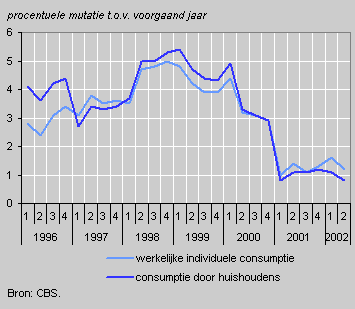Moderate growth in household consumption

Following a period of strong growth, the increase in consumption by households has been more moderate in the first half of this year. After correction for price changes, household spending was 1.0 percent higher than in the first half of last year. This is the same as the average increase in 2001.
Consumption by households

Unlike consumption by households, consumption by the government rose relatively strongly in the first half of 2002, by around three percent. The government is spending more on care and education in particular.
Consumption is the only bright spot on the spending side of the economy this year. Both investments and exports are at a lower level than twelve months previously. Because of the increase in consumption, the economy did not decline on balance in the first half of this year.
Lower growth in spending on transport and communications
The growth in household spending on services fell for the third year in a row. Corrected for price changes, households spent only 0.9 percent more on services. This is half the increase of 2001. Services constitute the largest spending category for households. Growth was slower for transport and communications in particular.
In the consumer goods category, spending on food, drink and tobacco was up though. In 2001 the volume of spending was at the same level as one year earlier. After a fall in spending on durable goods in 2001, the volume grew again in the first half of 2002. Households spent more on cars in particular. They spent less on clothes footwear and furniture than in the first half of last year.
Domestic consumption

Household consumption growth lagging
For the eighteen months to June 2002, the volume growth of consumption by households has been below that of real individual consumption. In this period government expenditure on medical care, welfare and education has risen particularly strongly.
In the second half of the nineties the picture was the other way around. In this period, household expenditure flourished under the influence of a favourable situation on the labour, house and stock markets. This boosted consumer spending on things like cars, furniture, computers and on transport and communications.
Karin van der Ven